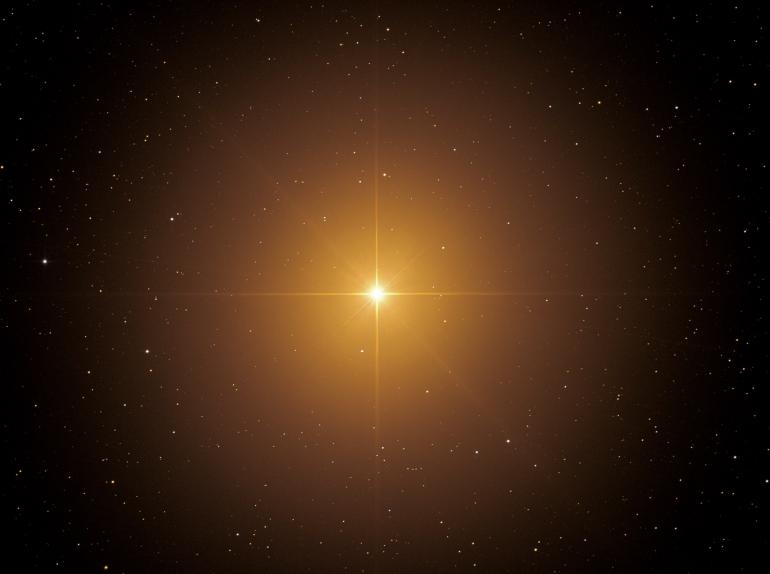Dancing with the Stars
Flashy speckles in the winter sky.
It was Walt Whitman—“America’s Poet”—who, after he’d heard the learned astronomer, went out and “look’d up in perfect silence at the stars.” In this season, that means the frosty stars of winter. Bright, shiny, and constant.
Except they aren’t constant—not really. All you have to do is look: as their narrow beams of starlight arrive at Earth from light years away, those beams get refracted—bent this way and that by the restless layers and currents of our atmosphere. It makes them “twinkle,” flickering like candles in a breeze.
This winter, when you’re looking up “in perfect silence at the stars,” don’t forget to seek out the exhibitionists, and have some fun with the universe!
But this is a superficial effect. In fact, many stars actually are inconstant, varying their brightness regularly or irregularly over time. Nearly all are so far and faint that they require telescopic observation to note their variability, but a few are bright enough for naked-eye viewing and can be quite exhibitionist.
Consider Betelgeuse, the bright orange star marking the shoulder of Orion the hunter, the upper left-hand star in the starry rectangle enclosing his distinctive belt of three stars, which shines in the south on clear winter nights. It’s a huffing, puffing, massive supergiant star nearing the end of its life, pulsating and varying its light modestly as it deals with the instabilities of old age. But in late 2019 and early 2020, the star dimmed dramatically—to about the same brightness as its neighbor Bellatrix, the star marking the upper right-hand corner of the rectangle.
Scientists ultimately determined that Betelgeuse ejected a substantial portion of its gassy surface; the gas cooled and condensed into dust and blocked some of the star’s light, making it look dimmer. As the cloud dispersed, Betelgeuse brightened up again, but it still hasn’t returned to its previous pulsation period.
Turn north to find a different kind of variable star. Locate the Big Dipper, then follow its “pointer stars” at the front of the bowl past the North Star to the W-shape of Cassiopeia. Alongside, beyond the flatter side of the W, you’ll find the sprawling K-shape of Perseus, the Greek hero who slew Medusa, ending her career of turning mortals into stone with a glance.
Consider Betelgeuse, the bright orange star marking the shoulder of Orion the hunter, the upper left-hand star in the starry rectangle enclosing his distinctive belt of three stars, which shines in the south on clear winter nights.
But she still leers at us: the arm of the K is the outstretched arm of Perseus clutching her severed head; the two unequally-bright stars at the end of the arm are her glowing eyes. And the brighter one—Algol, the “Demon Star”—winks at us.
Algol is an eclipsing binary: a pair of stars whose mutual orbit is edge-on to our line of sight, so they periodically eclipse each other. Algol’s main event occurs when the fainter star passes in front of the brighter every 2.87 days and the system dims from second magnitude to third (roughly matching the brightness of Medusa’s other eye) and then brightens again, all over a period of ten hours.
You can pinpoint Algol with the help of a star chart, and anticipate its eclipses using Sky & Telescope’s Algol Minimum Calculator (search “Minima of Algol”). Selected “prime-time” eclipse midpoints, with Perseus a little north of overhead, occur on December 30 a little after midnight, and on the evening of New Year’s Day at 9:42pm. Other selected brightness minima occur on January 4 at 6:31pm, January 24 at 8:16pm, February 5 at 7:33pm, February 13 at 10:02pm, and March 8 at 8:36pm. Mark your calendar, and see if you can catch Algol in mid-wink.
Finally, for a bit of fun, check out brilliant white Sirius, the brightest star in the sky, just after it rises in the southeast (around 9pm in mid-December; 7pm in mid-January), when it’s low and shining through more atmosphere. If the air is jumpy, its fierce twinkling can momentarily isolate individual parts of its light spectrum, making it flash all the colors of the rainbow in turn. Binoculars will enhance the show.
So this winter, when you’re looking up “in perfect silence at the stars,” don’t forget to seek out the exhibitionists, and have some fun with the universe!
Jim Manning is the former executive director of the Astronomical Society of the Pacific. He lives in Bozeman.














